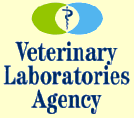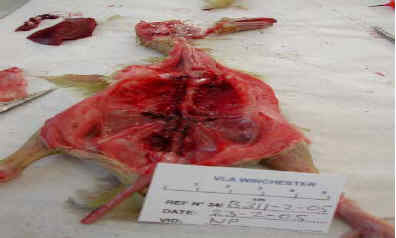



UK Poultry Disease Monthly Surveillance Report (to February 2005)
By Veterinary Laboratories Agency - This report monitors trends in the major endemic poultry diseases and utilises the farmfile and VIDA (Veterinary Investigation Disease Analysis) databases. The report is compiled using disease data gathered by the network of 15 VLA regional laboratories which carry out disease investigation in the field.
 Published February 2005 Highlights Infectious Bursal Disease causes losses in a flock of 8- 9 week old layer pullets Further deaths of wild birds associated with Salmonella typhimurium PT56 |
Poultry: Infectious Bursal Disease (IBD, Gumboro disease)
Gumboro disease was diagnosed in 8-9-week old layer pullets on a unit in which 1,500/11,000 had been lost since placement at day old. The number of deaths attributable to Gumboro alone was knot known. The presence of the disease was confirmed by AGP demonstrating antigen in the bursae of affected birds.
Haemorrhagic Enteritis in Turkeys
Haemorrhagic enteritis due to haemorrhagic enteritis virus (HEV, adenovirus)
was confirmed in a group of 13-week-old turkey rearing birds. Findings
included dark red contents throughout the intestinal tract and sloughing of the
mucosa in the upper small intestine. Histology showed a necrotic enteritis
associated with bacterial rods, and typical intranuclear inclusions in the
spleen. HEV antigen was demonstrated in the spleen. Alpha toxin of
Clostridium perfringens and coccidial oocysts were demonstrated in small
intestinal contents of one bird.
Winchester also reported an investigation into sudden death of 12 turkeys
aged 14 weeks. Post mortem examination of one affected bird revealed
typical lesions of haemorrhagic enteritis however laboratory tests failed to
confirm the presence of the virus.
Coccidiosis
Coccidial infections due to Eimeria necatrix and Eimeria tenella were seen in
31 week-old broiler breeder pullets and 23 week old caged layer pullets
respectively. These birds were submitted with a history of sudden drop in egg
production and increased daily mortality.
Post mortem examination revealed ballooning of mid to lower intestine with
light white plaques in areas of the serosal surface in the first case. Large
numbers of E.necatrix schizonts were present in wet smears. A distended
blood-filled caeca with large numbers of E.tenella schizonts was observed in
the second case.
Waterfowl
Winchester received a group of day old and 1 week old ducklings from a unit
in which ducklings were placed on a weekly basis for growing on. 30% of 150
day old ducklings were reported to have died over a 24 hour period, and 20%
of 1 week old ducklings. There had been a recent change of feed which was
originally suspected as a possible cause of mortality, but post mortem
examination revealed that the day old ducklings had not yet fed.
Some of the
birds had a striking reddish colouration to the carcase (fig.4) and carbon
monoxide poisoning was suspected. Gas brooders were used on the unit.
Tests on the blood of one affected bird revealed high levels of
carboxyhaemaglobin confirming the diagnosis.
Wildlife: Salmonellosis in garden birds
Salmonella enterica Typhimurium PT56 was the cause of three separate
cases of “garden bird mortality” reported to Langford. One involved sparrows
and two greenfinches. In one of the latter cases sixteen greenfinches had
been found dead over a one-month period in a Somerset garden. Three were
submitted for examination and S. Typhimurium PT56 isolated on direct culture
from all.
Duckling Showing Cherry Red Carcase Discolouration

To read the full report please click here (PDF)
Source: Veterinary Laboratories Agency - February 2005








